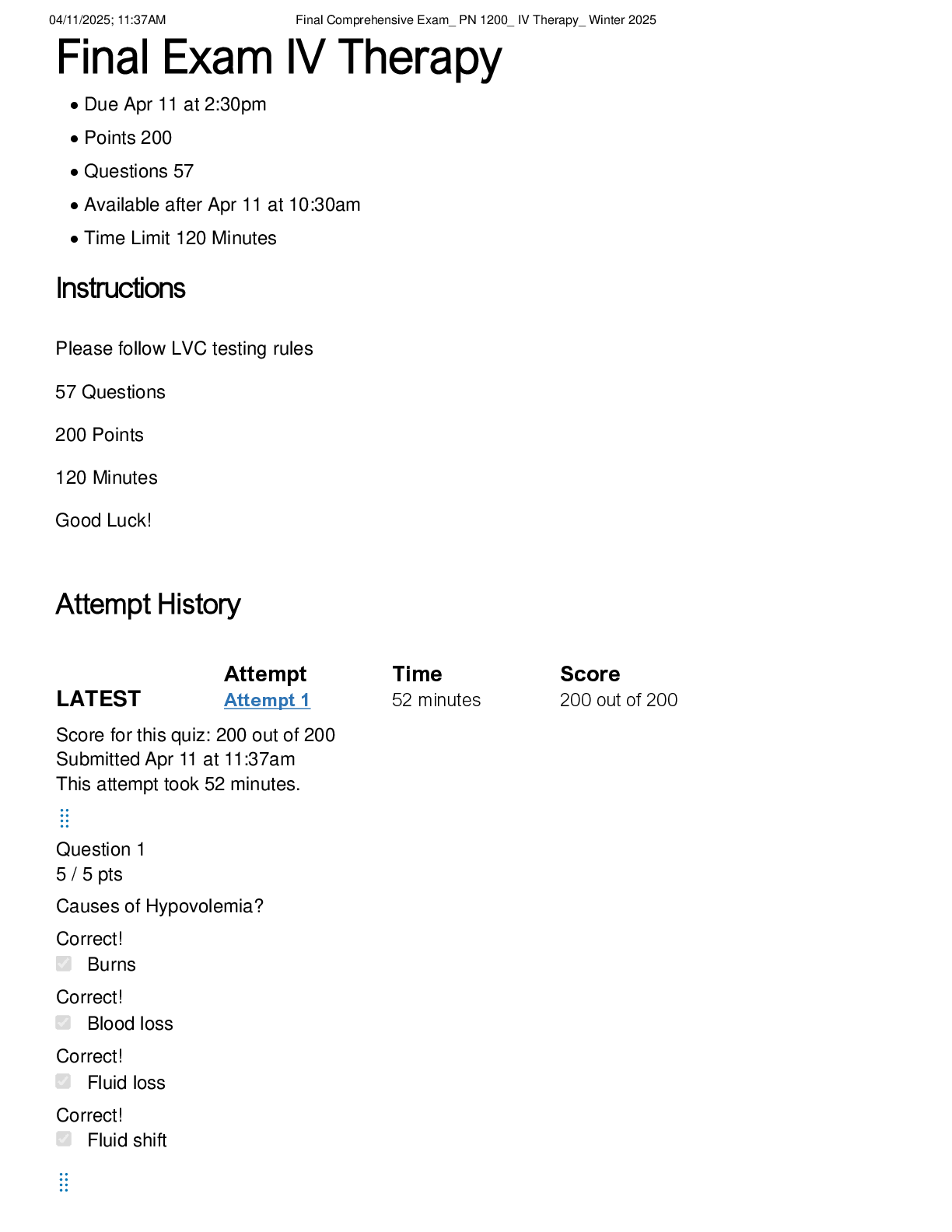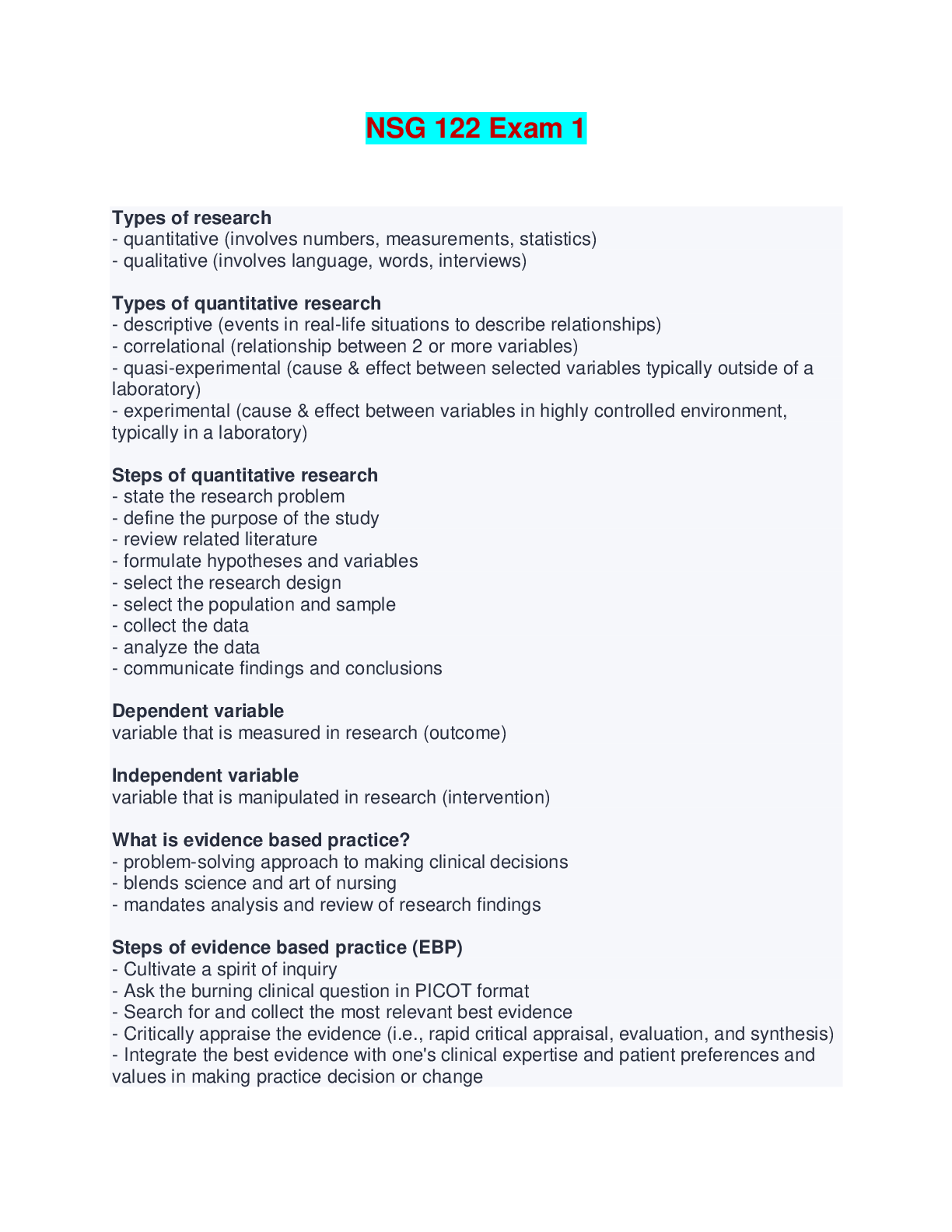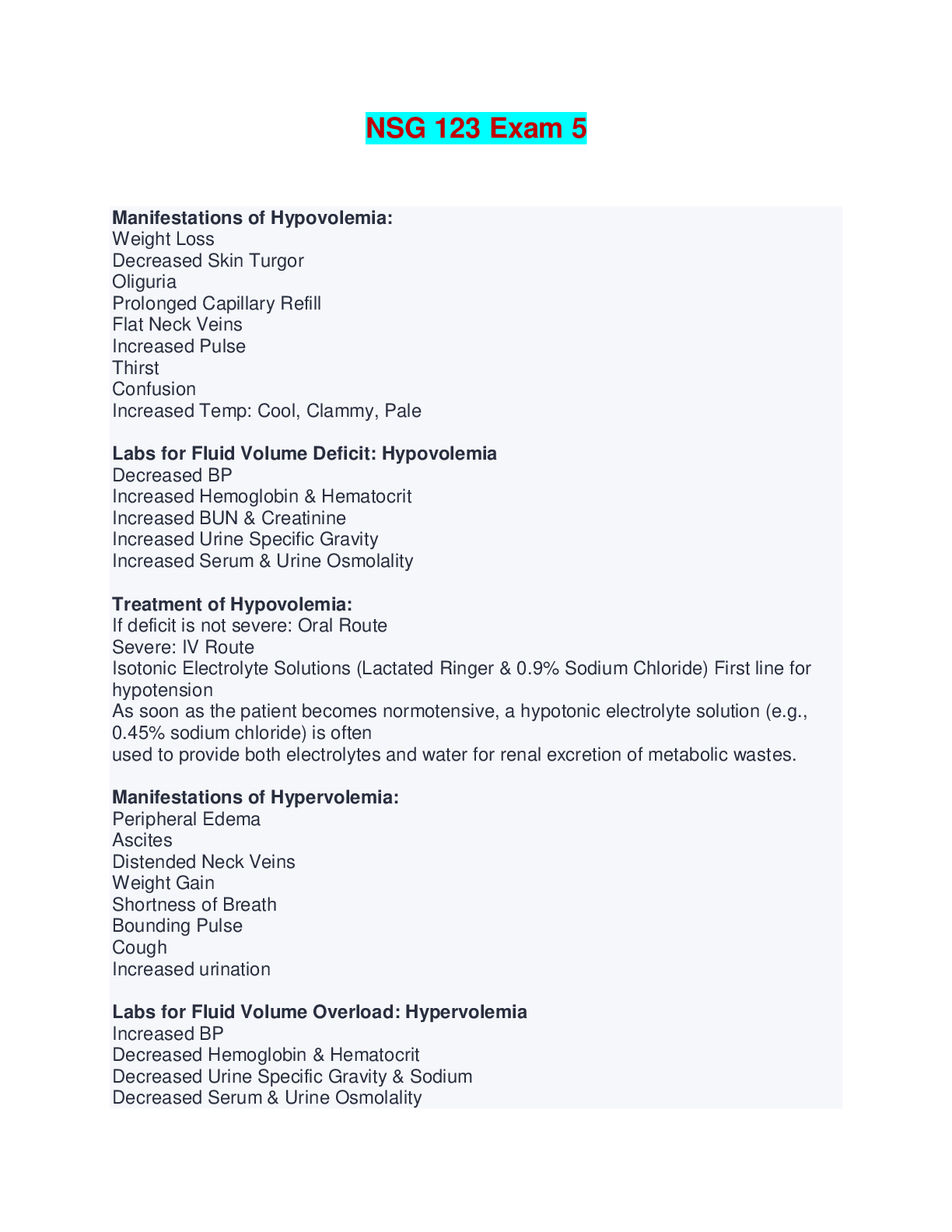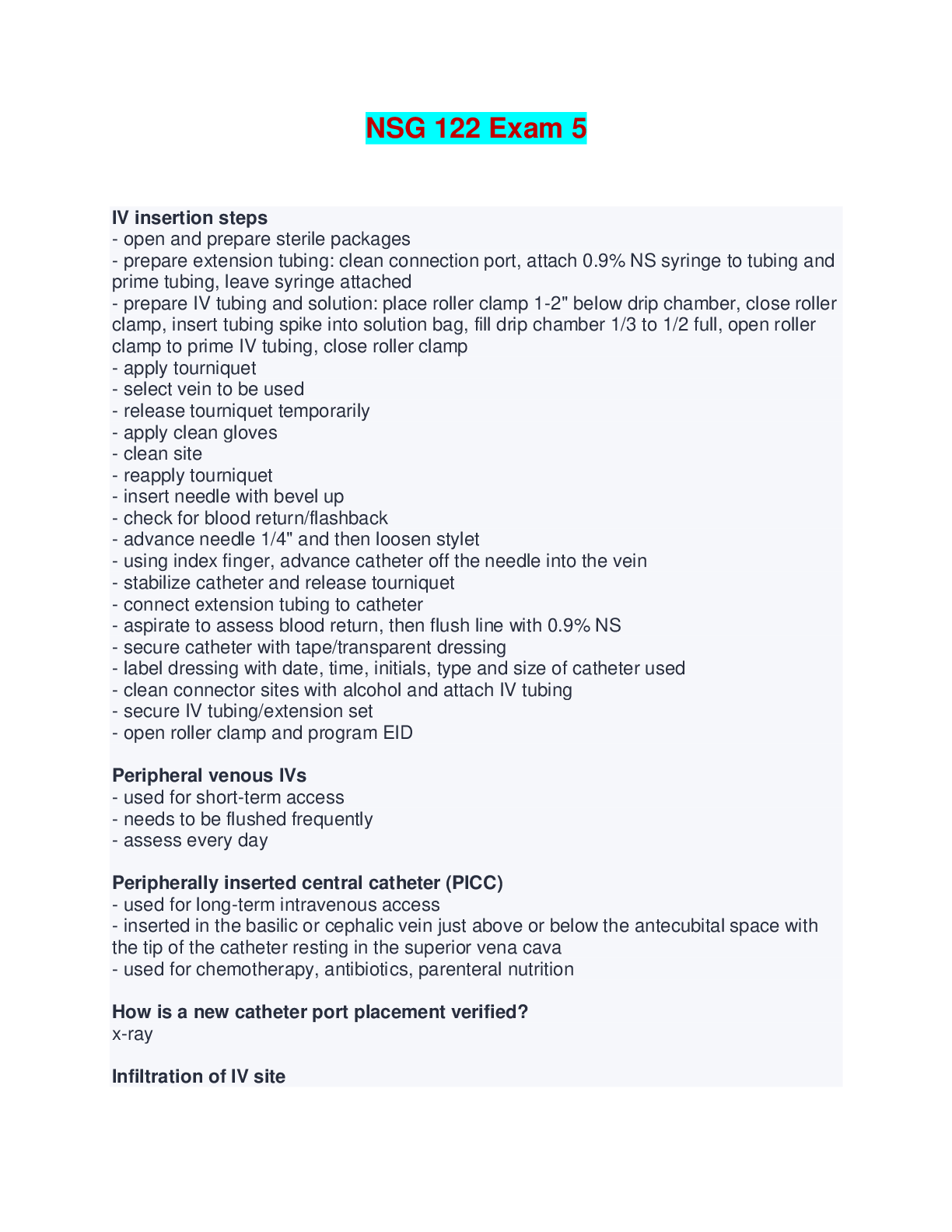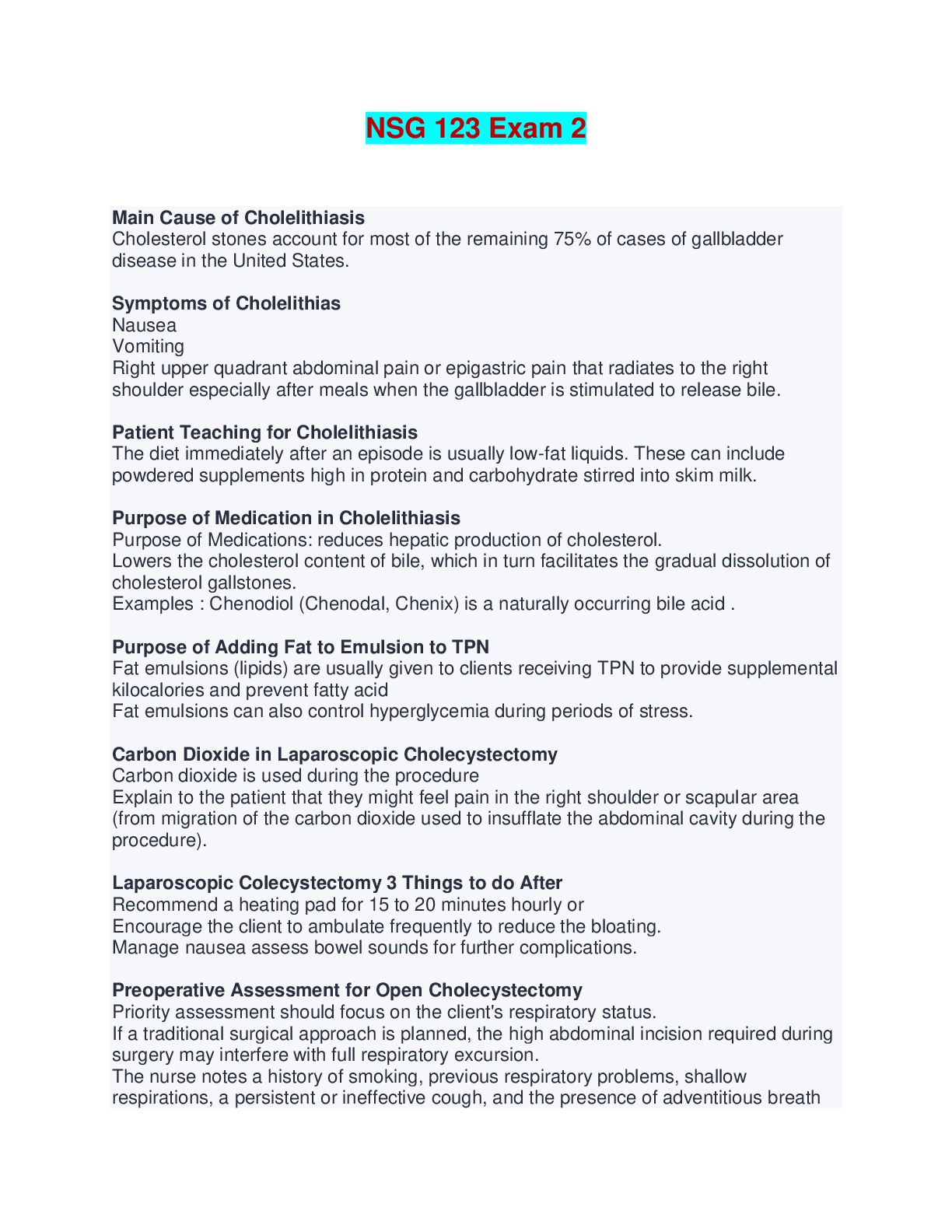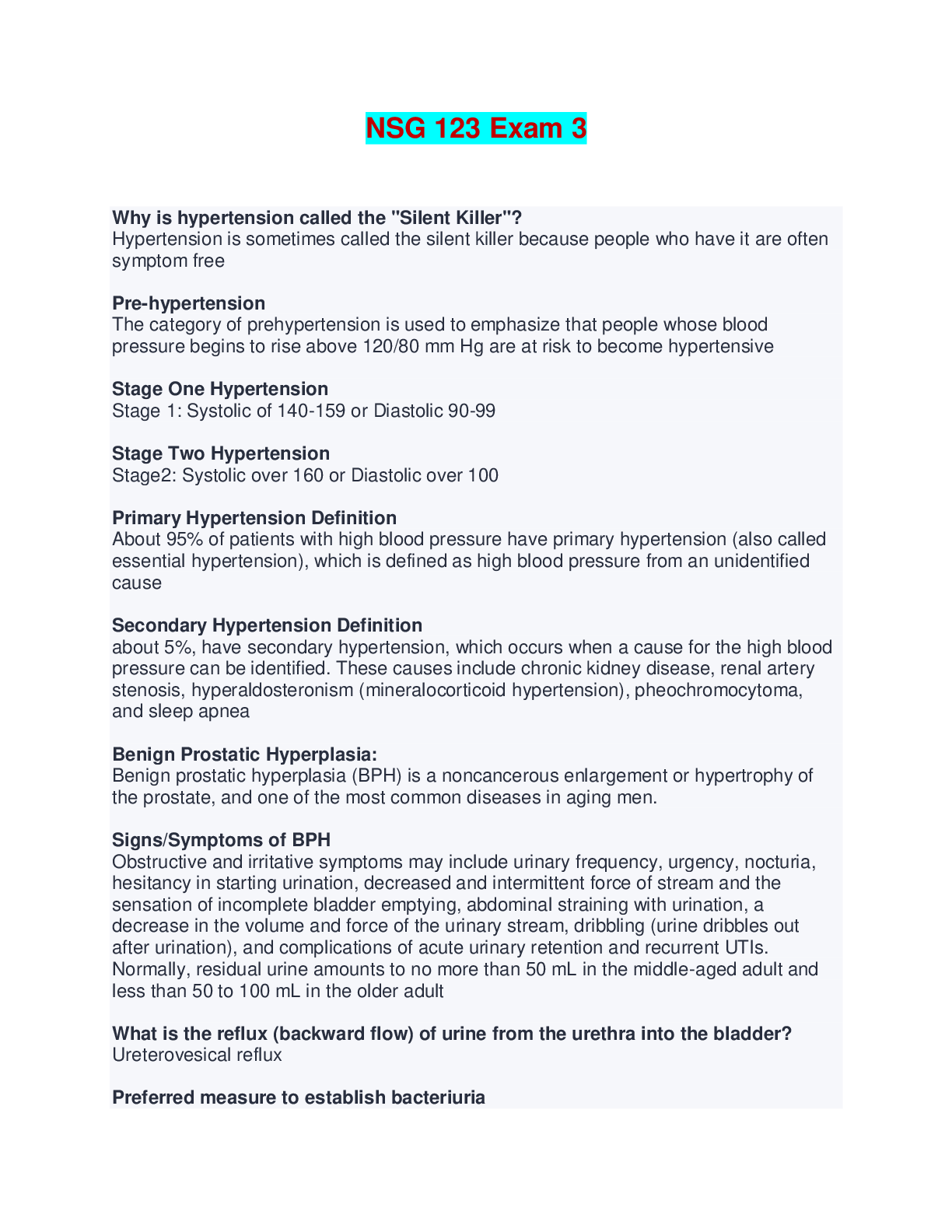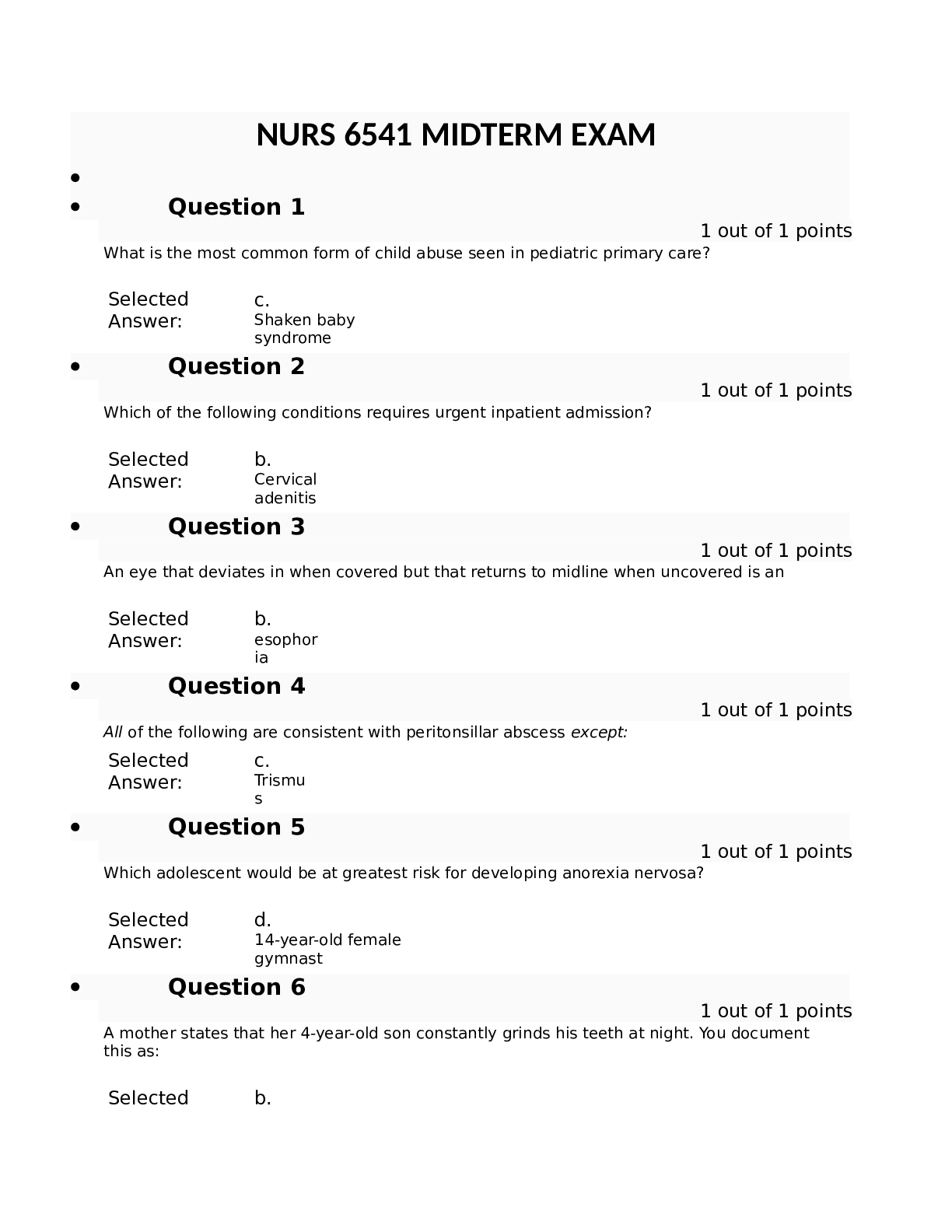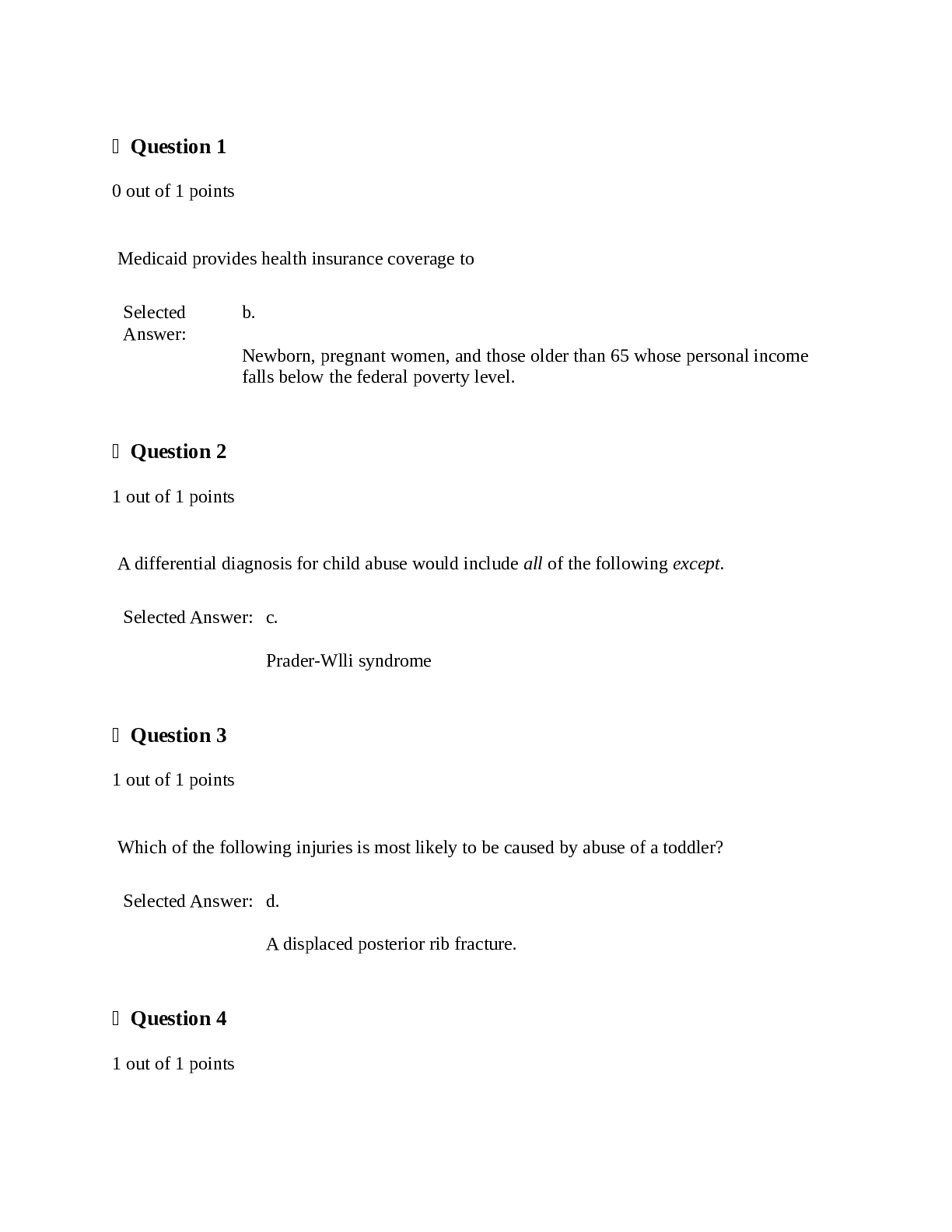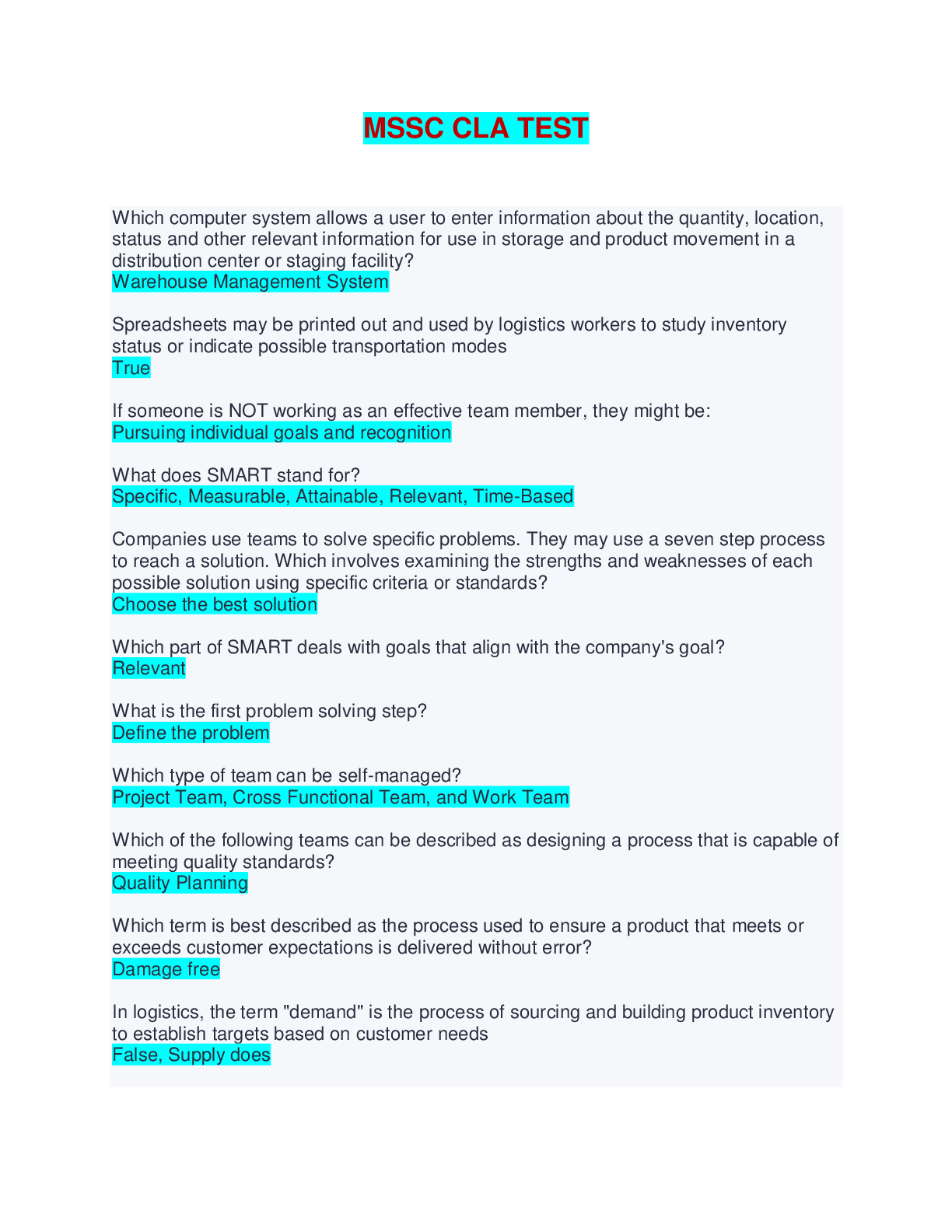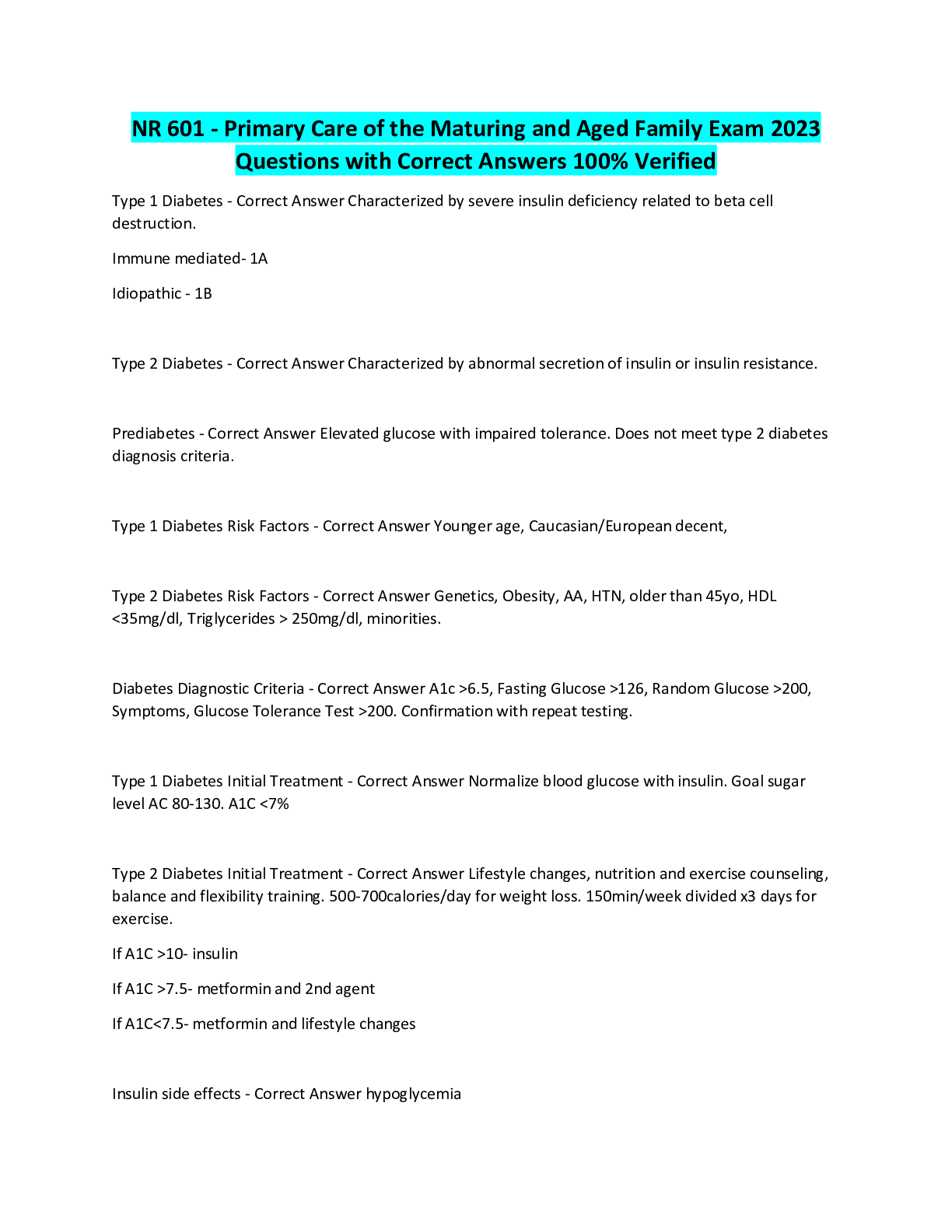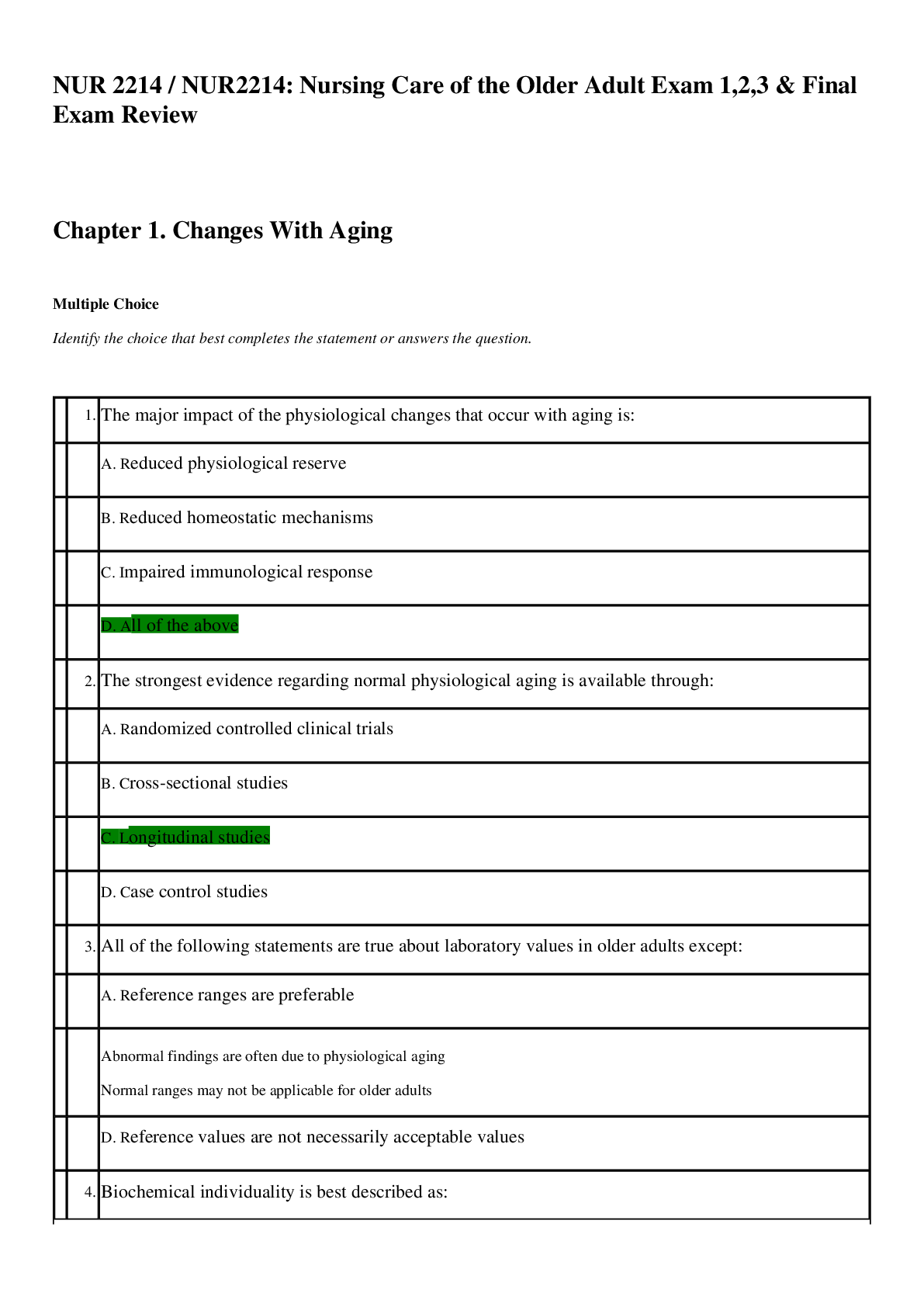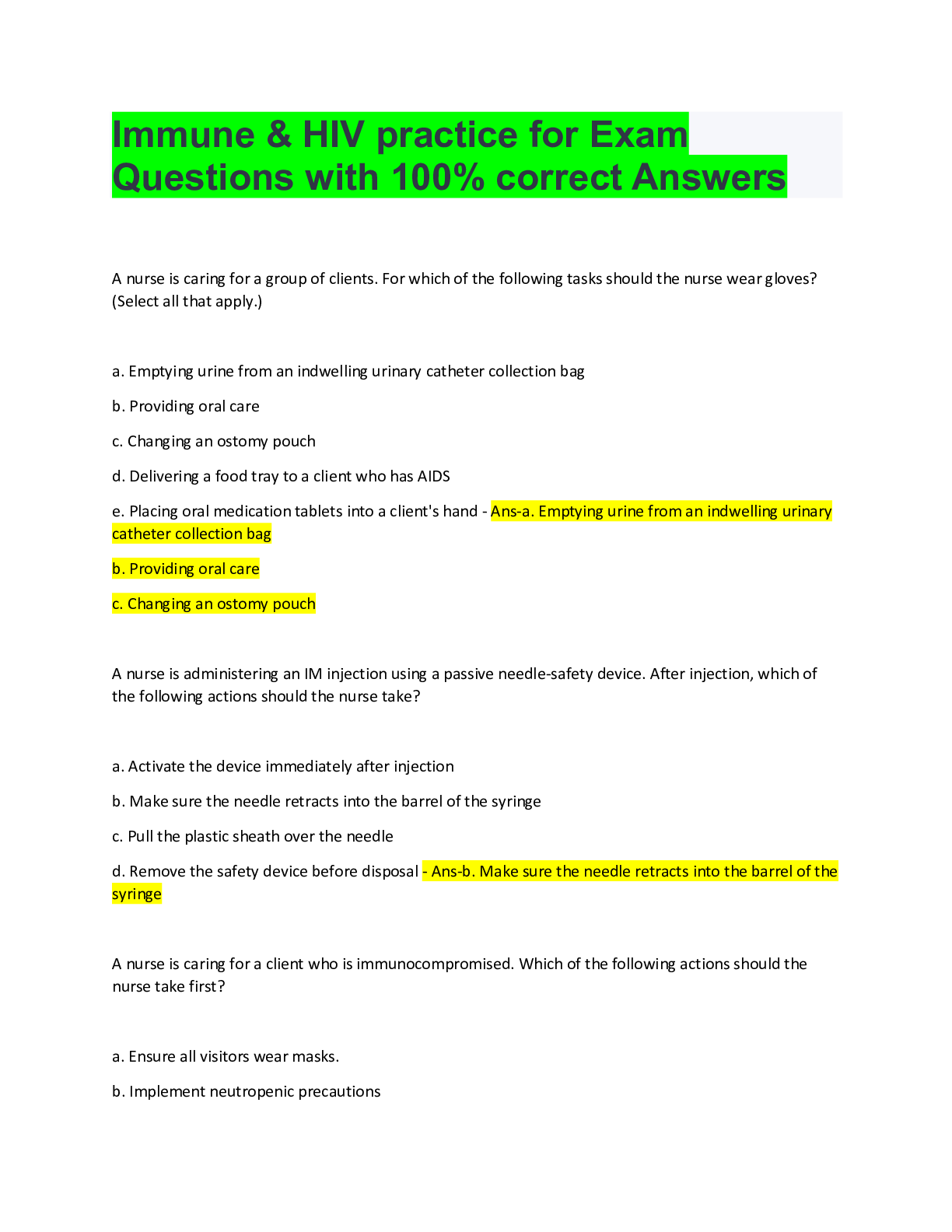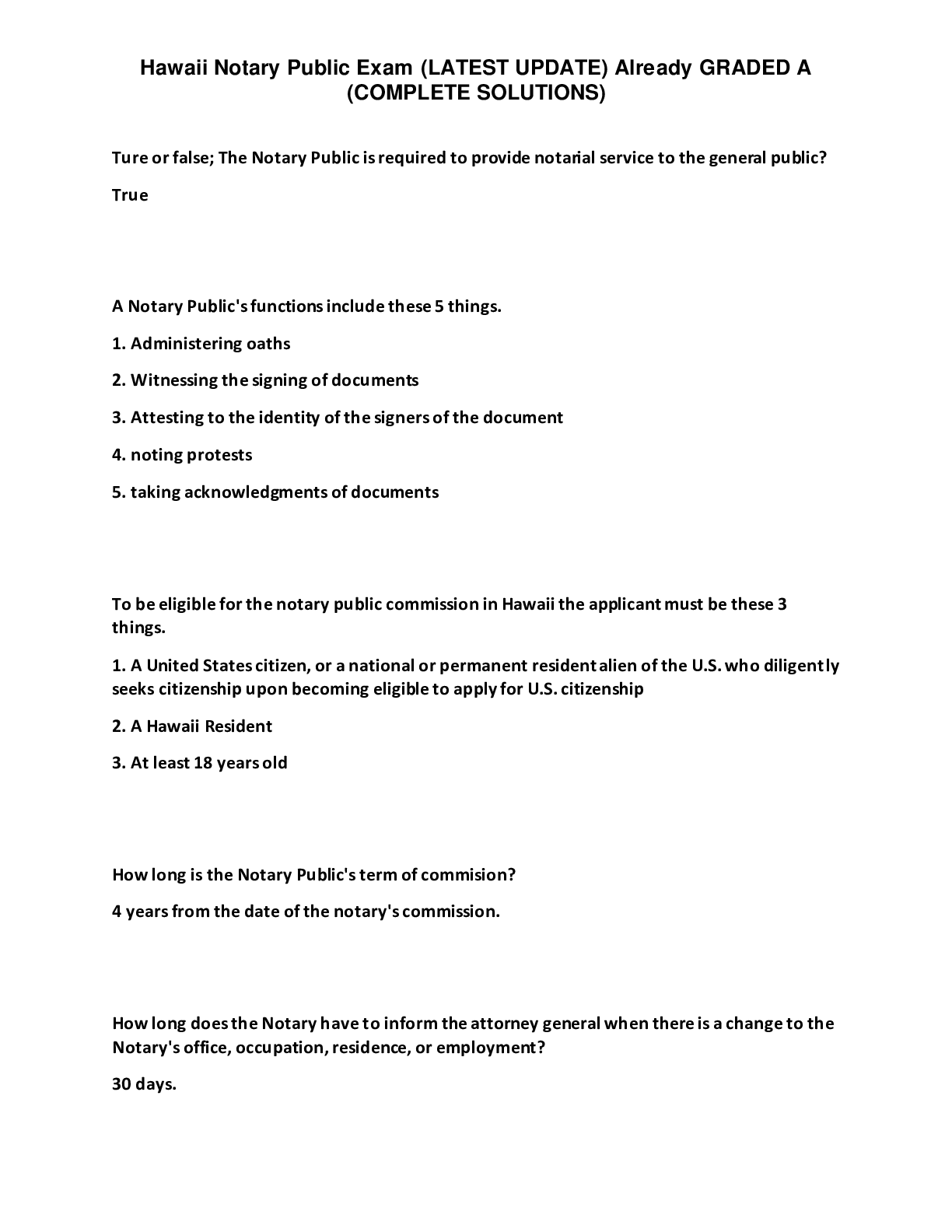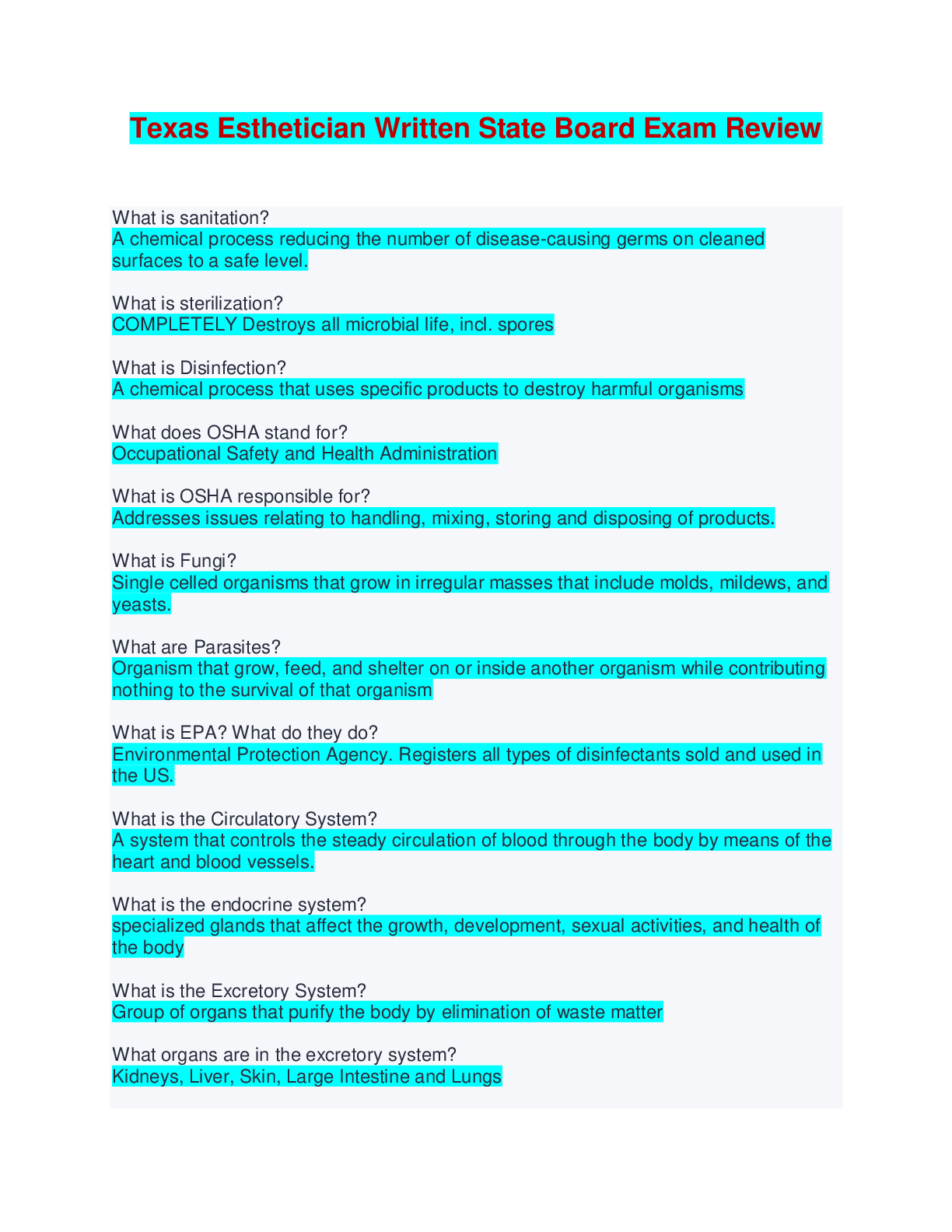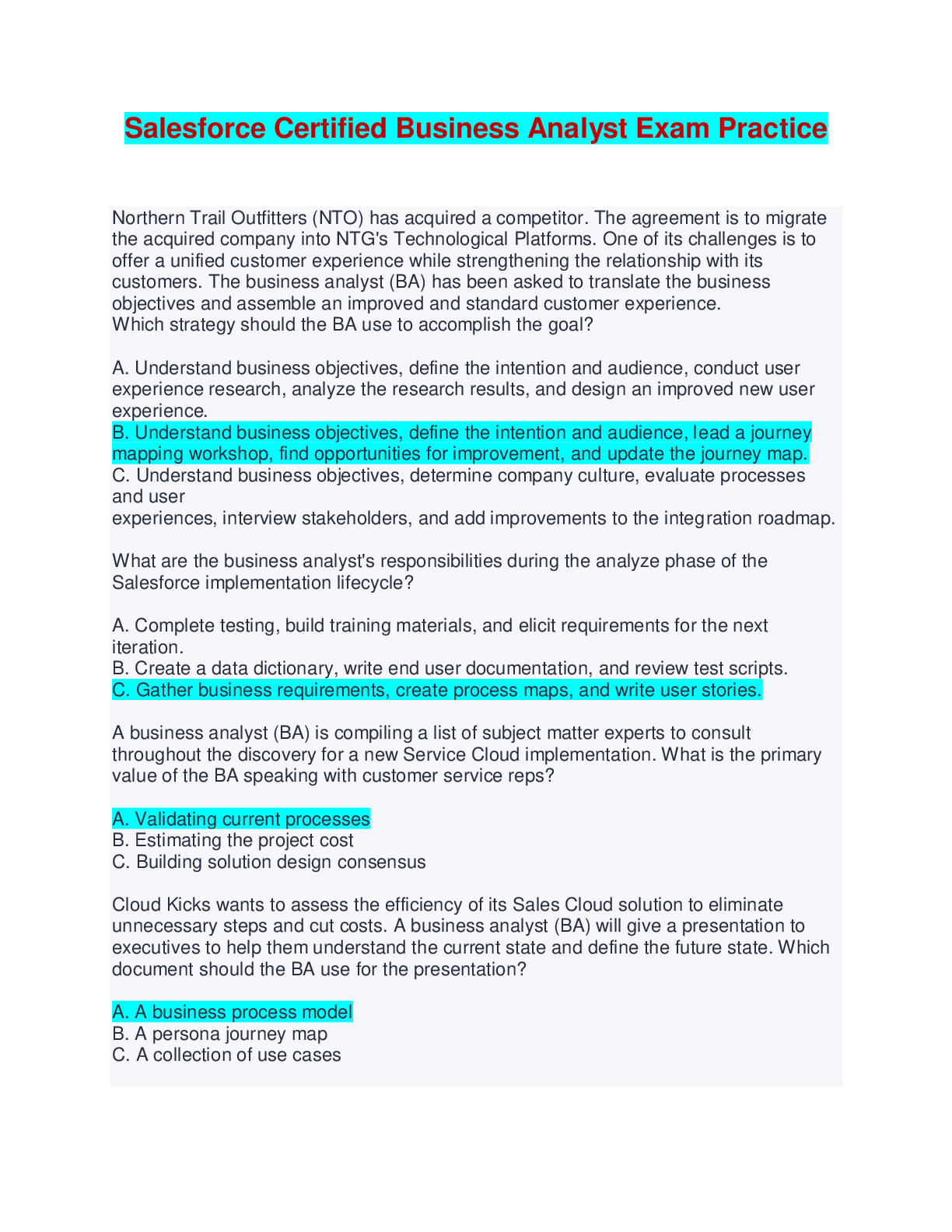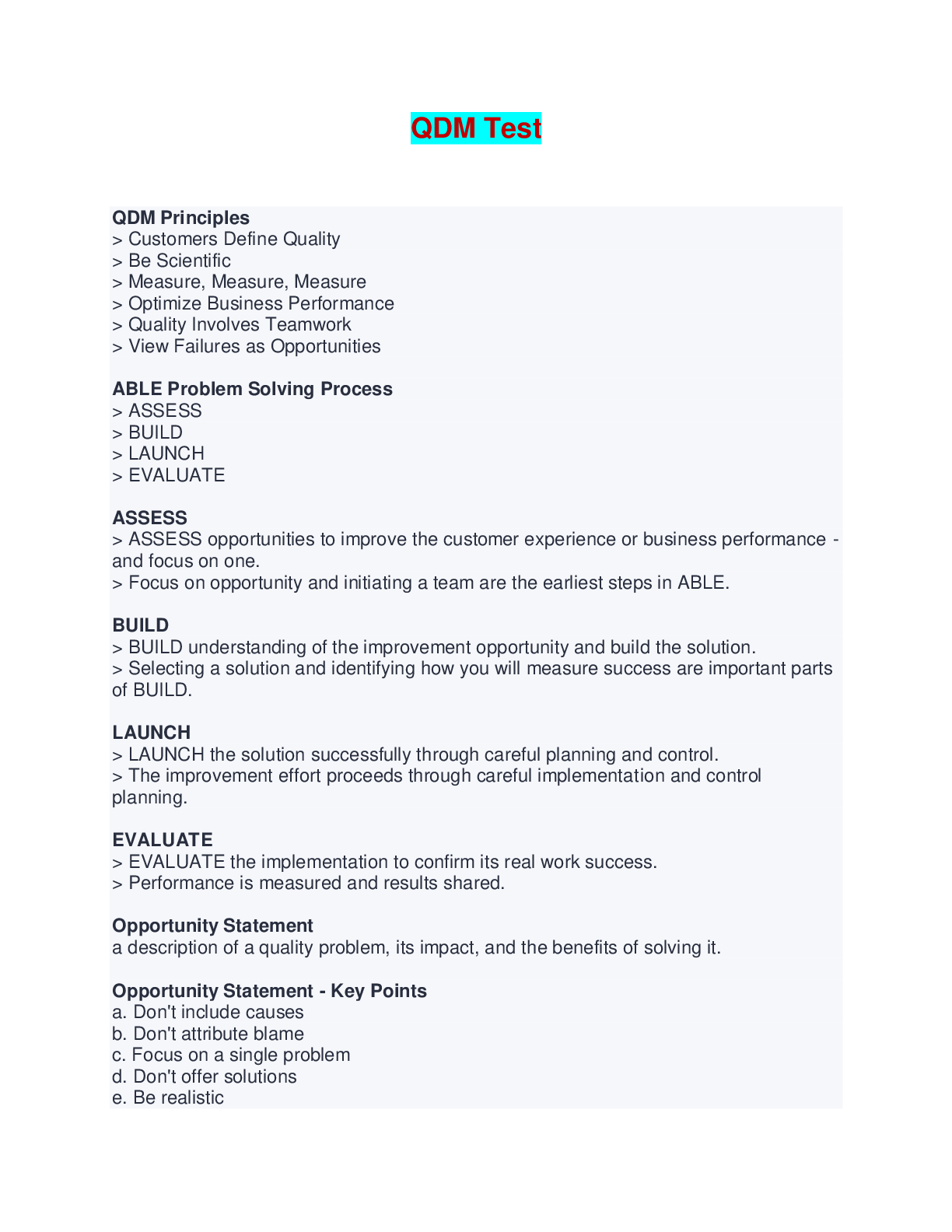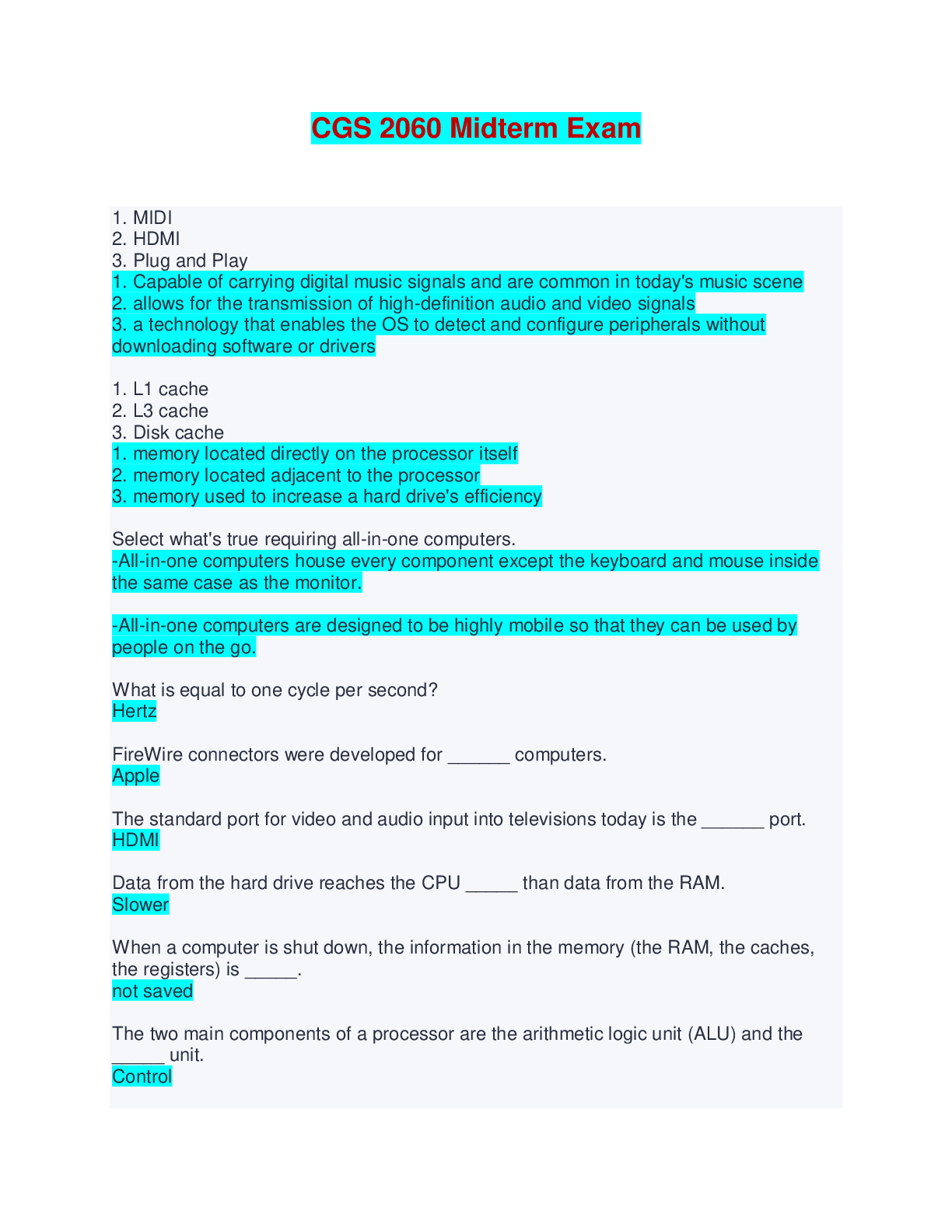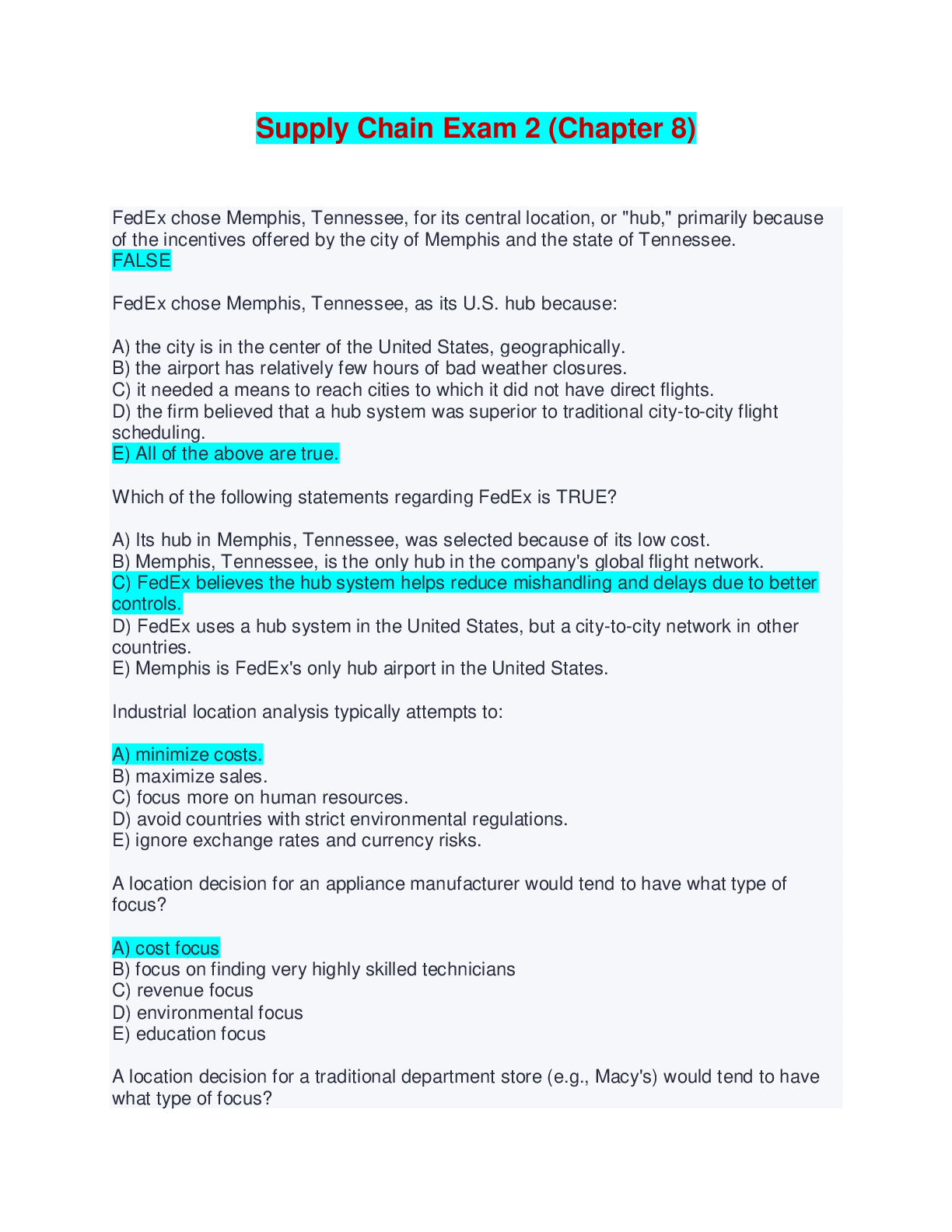Health Care > EXAM > Senior Seminar Peds Quiz 4 | Q & A (Complete Solutions) (All)
Senior Seminar Peds Quiz 4 | Q & A (Complete Solutions)
Document Content and Description Below
Senior Seminar Peds Quiz 4 | Q & A (Complete Solutions) The nurse is monitoring a child with burns during treatment for burn shock. Which assessment provides the most accurate guide to determine th... e adequacy of fluid resuscitation? 1. Skin Turgor 2. Level of edema at burn site 3. Adequacy of capillary filling 4. Amount of fluid tolerated in 24 hours The mother of a 3-year-old child arrives at a clinic and tells the nurse that the child has been scratching the skin continuously and has developed a rash. The nurse assesses the child and suspects the presence of scabies. The nurse bases this suspicion on which finding noted on assessment of the child's skin? 1. Fine grayish red lines 2. Purple-colored lesions 3. Thick, honey-colored crusts 4. Clusters of fluid-filled vesicles Permethrin is prescribed for a child with a diagnosis of scabies. The nurse should give which instruction to the parents regarding the use of this treatment? 1. Apply the lotion to areas of the rash only 2. Apply the lotion and leave it on for 6 hours 3. Avoid putting clothes on the child over the lotion 4. Apply the lotion to cool, dry skin at least 30 minutes after bathing The school nurse has provided an instructional session about impetigo to parents of the children attending the school. Which statement, if made by a parent, indicates a need for further instruction? 1. "It is extremely contagious." 2. "It is most common in humid weather." 3. "Lesions most often are located on the arms and chest." 4. "It might show up in an area of broken skin, such as an insect bite." The clinic nurse is reviewing the health care provider's prescription for a child who has been diagnosed with scabies. Lindane has been prescribed for the child. The nurse questions the prescription if which is noted in the child's record? 1. The child is 18 months old 2. The child is being bottle-fed 3. A sibling is using Lindane for the treatment of scabies 4. The child has a history of frequent respiratory infections A topical corticosteroid is prescribed by the HCP for a child with atopic dermatitis (eczema). Which instruction should the nurse give the parent about applying the cream? 1. Apply the cream over the entire body 2. Apply a thick layer of cream to affected areas only 3. Avoid cleansing the area before application of the cream 4. Apply a thin layer of cream and rub it into the area thoroughly The school nurse is performing pediculous capitis (head lice) assessments. Which assessment finding indicates that a child has a "positive" head check? 1. Maculopapular lesions behind the ears 2. Lesions in the scalp that extend to the hairline or neck 3. White flaky particles throughout the entire scalp region 4. White sacs attached to the hair shafts in the occipital area The nurse analyzes the lab results of a child with hemophilia. The nurse understands that which result will most likely be abnormal in this child? 1. Platelet count 2. Hct level 3. Hgb level 4. Partial thromboplastin time The nurse is providing home care instructions to the parents of a 10-year-old child with hemophilia. Which sport activity should the nurse suggest for this child? 1. Soccer 2. Basketball 3. Swimming 4. Field hockey The nursing student is presenting a clinical conference and discusses the cause of b-thalassemia. The nursing student informs the group that a child at greatest risk of developing this disorder is which of these? 1. A child of Mexican descent 2. A child of Mediterranean descent 3. A child whose intake of iron is extremely poor 4. A breast-fed child of a mother with chronic anemia A child with b-thalassemia is receiving long-term blood transfusion therapy for the treatment of the disorder. Chelation therapy is prescribed as a result of too much iron from the transfusions. Which medication should the nurse anticipate to be prescribed? 1. Fragmin 2. Meropenem 3. Metoprolol 4. Deferoxamine The clinic nurse instructs parents of a child with sickle cell anemia about the precipitating factors related to sickle cell crisis. Which, if identified by the parents as a precipitating factor, indicates the need for further instruction? 1. Stress 2. Trauma 3. Infection 4. Fluid overload A 10-year-old child with hemophilia A has slipped on the ice and bumped his knee. The nurse should prepare to administer which prescription? 1. Injection of factor X 2. IV infusion of iron 3. IV infusion of factor VIII 4. IM injection of iron using the Z-track method The nurse is instructing the parents of a child with iron deficiency anemia regarding the administration of a liquid oral iron supplement. Which instruction should the nurse tell the parents? 1. Administer the iron at mealtimes 2. Administer the iron through a straw 3.Mix the iron with cereal to administer 4. Add the iron to formula for easy administration Lab studies are performed for a child suspected to have iron deficiency anemia. The nurse reviews the lab results, knowing that which result indicates this type of anemia? 1. Elevated Hgb level 2. Decreased reticulocyte count 3. Elevated RBC count 4. RBCs that are microcytic and hypochromic The nurse is monitoring a child for bleeding after surgery for removal of a brain tumor. The nurse checks the head dressing for the presence of blood and notes a colorless drainage on the back of the dressing. Which intervention should the nurse perform immediately? 1. Reinforce the dressing 2. Notify the HCP 3. Document the findings and continue to monitor 4. Circle the area of drainage and continue to monitor A child undergoes surgical removal of brain tumor. During the postop period, the nurse notes that the child is restless, the pulse rate is elevated, and the blood pressure has decreased significantly from the baseline value. The nurse suspects that the child is in shock. Which is the most appropriate nursing action? 1. Place the child in the supine position 2. Notify the HCP 3. Place the child in the Trendelenburg position 4. Increase the flow rate of the IV fluids The mother of a 4-year-old child tells the pediatric nurse that the child's abdomen seems to be swollen. During further assessment, the mother tells the nurse that the child is eating well and that the activity level of the child is unchanged. The nurse, suspecting the possibility of Wilms' tumor, should avoid which during the physical assessment? 1. Palpating the abdomen for a mass 2. Assessing the urine for the presence of hematuria 3. Monitoring the temp for the presence of fever 4. Monitoring the BP for the presence of HTN The nurse provides a teaching session to the nursing staff regarding osteosarcoma. Which statement by a member of the nursing staff indicates a need for information? 1. "The femur is the most common site of this sarcoma." 2. "The child does not experience pain at the primary tumor site." 3. "Limping, if a weight-bearing limb is affected, is a clinical manifestation." 4. "The symptoms of the disease in the early stage are almost always attributed to normal growing pains." The nurse analyzes the lab values of a child with leukemia who is receiving chemo. The nurse notes that the platelet count is 19,500 mm3. On the basis of this lab result, which intervention should the nurse include in the plan of care? 1. Initiate bleeding precautions 2. Monitor closely for signs of infection 3. Monitor the temp every 4 hours 4. Initiate protective isolation precautions The nurse is monitoring a 3-year-old child for signs and symptoms of increased ICP after a craniotomy. The nurse plans to monitor for which early sign or symptom of increased ICP? 1. Vomiting 2. Bulging anterior fontanel 3. Increasing head circumference 4. Complaints of a frontal headache A 4-year-old child is admitted to the hospital for abdominal pain. The mother reports that the child has been pale and excessively tired and is bruising easily. On physical examination, lymphadenopathy and hepatosplenomegaly are noted. Diagnostic studies are being performed because acute lymphocytic leukemia is suspected. The nurse determines that which lab result confirms the diagnosis? 1. Lumbar puncture showing no blast cells 2. Bone marrow biopsy showing blast cells 3. Platelet count of 350,000 mm3 4. WBC count 4500 mm3 A 6-year-old child with leukemia is hospitalized and is receiving combination chemo. Lab results indicate that the child is neutropenic, and protective isolation procedures are initiated. The grandmother of the child visits and brings a fresh bouquet of flowers picked from her garden, and asks the nurse for a vase for the flowers. Which response should the nurse provide to the grandmother? 1. "I have a vase in the utility room, and I will get it for you." 2. "I will get the vase and wash it well before you put the flowers in it." 3. "The flowers from your garden are beautiful, but should not be placed in the child's room at this time." 4. "When you bring the flowers into the room, place them on the bedside stand as far away from the child as possible." A diagnosis of Hodgkin's disease is suspected in a 12-year-old child. Several diagnostic studies are performed to determine the presence of this disease. Which diagnostic test result will confirm the diagnosis of Hodgkin's disease? 1. Elevated vanillylmandelic acid urinary levels 2. The presence of blast cells in the bone marrow 3. The presence of EBV in the blood 4. The presence of Reed-Sternberg cells in the lymph nodes A school-aged child with type 1 DM has soccer practice and the school nurse provides instructions regarding how to prevent hypoglycemia during practice. Which should the school nurse tell the child to do? 1. Eat twice the amount normally eaten at lunchtime 2. Take half the amount of prescribed insulin on practice days 3. Take the prescribed insulin at noontime rather than in the morning 4. Eat a small box of raisins or drink a cup of orange juice before soccer practice The mother of a 6-year-old child who has type 1 DM calls a clinic nurse and tells the nurse that the child has been sick. The mother reports that she checked the child's urine and it was positive for ketones. The nurse should instruct the mother to take which action? 1. Hold the next dose of insulin 2. Come to the clinic immediately 3. Encourage the child to drink liquids 4. Administer an additional dose of regular insulin A HCP prescribes an IV solution of D5 1/2 NS with 40 mEq of potassium chloride for a child with hypotonic dehydration. The nurse performs which priority assessment before administering this IV prescription? 1. Obtains a weight 2. Takes the temp 3. Takes the BP 4. Checks the amount of urine output An adolescent client with type 1 DM is admitted to the ED for treatment of DKA. Which assessment findings should the nurse expect to note? 1. Sweating and tremors 2. Hunger and HTN 3. Cold, clammy skin and irritability 4. Fruity breath odor and decreasing level of consciousness A mother brings her 3-week-old infant to a clinic for a PKU rescreening blood test. The test indicates a serum phenylalanine level of 1 mg/dL. The nurse reviews this result and makes which interpretation? 1. It is positive 2. It is negative 3. It is inconclusive 4. It requires rescreening at age 6 weeks A child with type 1 DM is brought to the ED by the mother, who states that the child has been complaining of abdominal pain and has been lethargic. DKA is diagnosed. Anticipating the plan of care, the nurse prepares to administer which type of IV infusion? 1. Potassium infusion 2. NPH insulin infusion 3. 5% dextrose infusion 4. Normal saline infusion The nurse has just administered ibuprofen to a child with a temp of 102F. The nurse should also take which action? 1. Withhold oral fluids for 8 hours 2. Sponge the child with cold water 3. Plan to administer salicylate in 4 hours 4. Remove excess clothing and blankets from the child A child has fluid volume deficit. The nurse performs an assessment and determines that the child is improving and the deficit is resolving if which finding is noted? 1. The child has no tears 2. Urine specific gravity is 1.035 3. Cap refill is less than 2 seconds 4. Urine output is less than 1 mL/kg/hour The clinic nurse review the record of an infant and notes that the HCP has documented a diagnosis of suspected Hirschsprung's disease. The nurse reviews the assessment findings documented in the record, knowing that which sign most likely led the mother to seek health care for the infant? 1. Diarrhea 2. Projectile vomiting 3. Regurgitation of feedings 4. Foul-smelling ribbon-like stools An infant has just returned to the nursing unit after surgical repair of a cleft lip on the right side. The nurse should place the infant in which best position at this time? 1. Prone position 2. On the stomach 3. Left lateral position 4. Right lateral position The nurse reviews the record of a newborn infant and notes that a diagnosis of esophageal atresia with tracheoesophageal fistula is suspected. The nurse expects to note which most likely sign of this condition documented in the record? 1. Incessant crying 2. Coughing at night time 3. Choking with feedings 4. Severe projectile vomiting The nurse provides feeding instructions to a parent of an infant diagnosed with GERD. Which instruction should the nurse give to the parent to assist in reducing the episodes of emesis? 1. Provide less frequent, larger feedings 2. Burp the infant less frequently during feedings 3. Thin the feedings by adding water to the formula 4. Thicken the feedings by adding rice cereal to the formula A child is hospitalized because of persistent vomiting. The nurse should monitor the child closely for which problem? 1. Diarrhea 2. Metabolic acidosis 3. Metabolic alkalosis 4. Hyperactive bowel sounds The nurse is caring for a newborn with a suspected diagnosis of inperforate anus. The nurse monitors the infant, knowing that which is a clinical manifestation associated with this disorder? 1. Bile'stained fecal emesis 2. The passage of currant jelly-like stools 3. Failure to pass meconium stool in the first 24 hours after birth 4. Sausage-shaped mass palpated in the upper right abdominal quadrant The nurse admits a child to the hospital with a diagnosis of pyloric stenosis. On assessment, which data would the nurse expect to obtain when asking the parent about the child's symptoms? 1. Watery diarrhea 2. Projectile vomiting 3. Increased urine output 4. Vomiting large amounts of bile The nurse provides home care instructions to the parents of a child with celiac disease. The nurse should teach the parents to include which food item in the child's diet? 1. Rice 2. Oatmeal 3. Rye toast 4. Wheat bread The nurse is preparing to care for a child with a diagnosis of intussusception. The nurse reviews the child's record and expects to note which sign of this disorder documented? 1. Watery diarrhea 2. Ribbon-like stools 3. Profuse projectile vomiting 4. Bright red blood and mucus in the stools After a tonsillectomy, a child begins to vomit bright red blood. The nurse should take which initial action? 1. Turn the child to the side 2. Administer the prescribed antiemetic 3. Notify the HCP 4. Maintain NPO status The mother of a 6-year-old child arrives at a clinic because the child has been experiencing itchy, red, and swollen eyes. The nurse notes a discharge from the eyes and sends a culture to the lab for analysis. Chlamydial conjunctivitis is diagnosed. On the basis of this diagnosis, the nurse determines that which requires further investigation? 1. Possible trauma 2. Possible sexual abuse 3. Presence of an allergy 4. Presence of a respiratory infection The nurse prepares a teaching plan for the mother of a child diagnosed with bacterial conjunctivitis. Which, if stated by the mother, indicates a need for further teaching? 1. "I need to wash my hands frequently." 2. "I need to clean the eye as prescribed." 3. "It is okay to share towels and washcloths." 4. "I need to give the eye drops as prescribed." The nurse is reviewing the lab results for a child scheduled for a tonsillectomy. The nurse determines that which lab value is most significant to review? 1. Creatainine level 2. PT time 3. Sedimentation rate 4. BUN level The nurse is preparing to care for a child after a tonsillectomy. The nurse documents on the plan of care to place the child in which position? 1. Supine 2. Side-lying 3. High Fowler's 4. Trendelenburg After a tonsillectomy, the nurse reviews the HCP's postop prescriptions. Which prescription should the nurse question? 1. Monitor for bleeding 2. Suction every 2 hours 3. Give no milk or milk products 4. Give clear, cool liquids when awake and alert The nurse is caring for a child after a tonsillectomy. The nurse monitors the child, knowing that which finding indicates the child is bleeding? 1. Frequent swallowing 2. A decreased pulse rate 3. Complaints of discomfort 4. An elevation in BP Antibiotics are prescribed for a child with otitis media who underwent a myringotomy with insertion of tympanostomy tubes. The nurse provides discharge instructions to the parents regarding the administration of the antibiotics. Which statement, if made by the parents, indicates understanding of the instructions provided? 1. "Administer the antibiotics until they are gone." 2. "Administer the antibiotics if the child has a fever." 3. "Administer the antibiotics until the child feels better." 4. "Begin to taper the antibiotics after 3 days of a full course." The day care nurse is observing a 2-year-old child and suspects that the child may have strabismus. Which observation made by the nurse indicates the presence of this condition? 1. The child has difficulty hearing 2. The child consistently tilts the head to see 3. The child does not respond when spoken to 4. The child consistently turns the head to hear A 10-year-old child with asthma is treated for acute exacerbation in the ED. The nurse caring for the child should monitor for which sign, knowing that it indicates a worsening of the condition? 1. Warm, dry skin 2. Decreased wheezing [Show More]
Last updated: 7 months ago
Preview 5 out of 23 pages

Loading document previews ...
Buy this document to get the full access instantly
Instant Download Access after purchase
Buy NowInstant download
We Accept:

Also available in bundle (1)
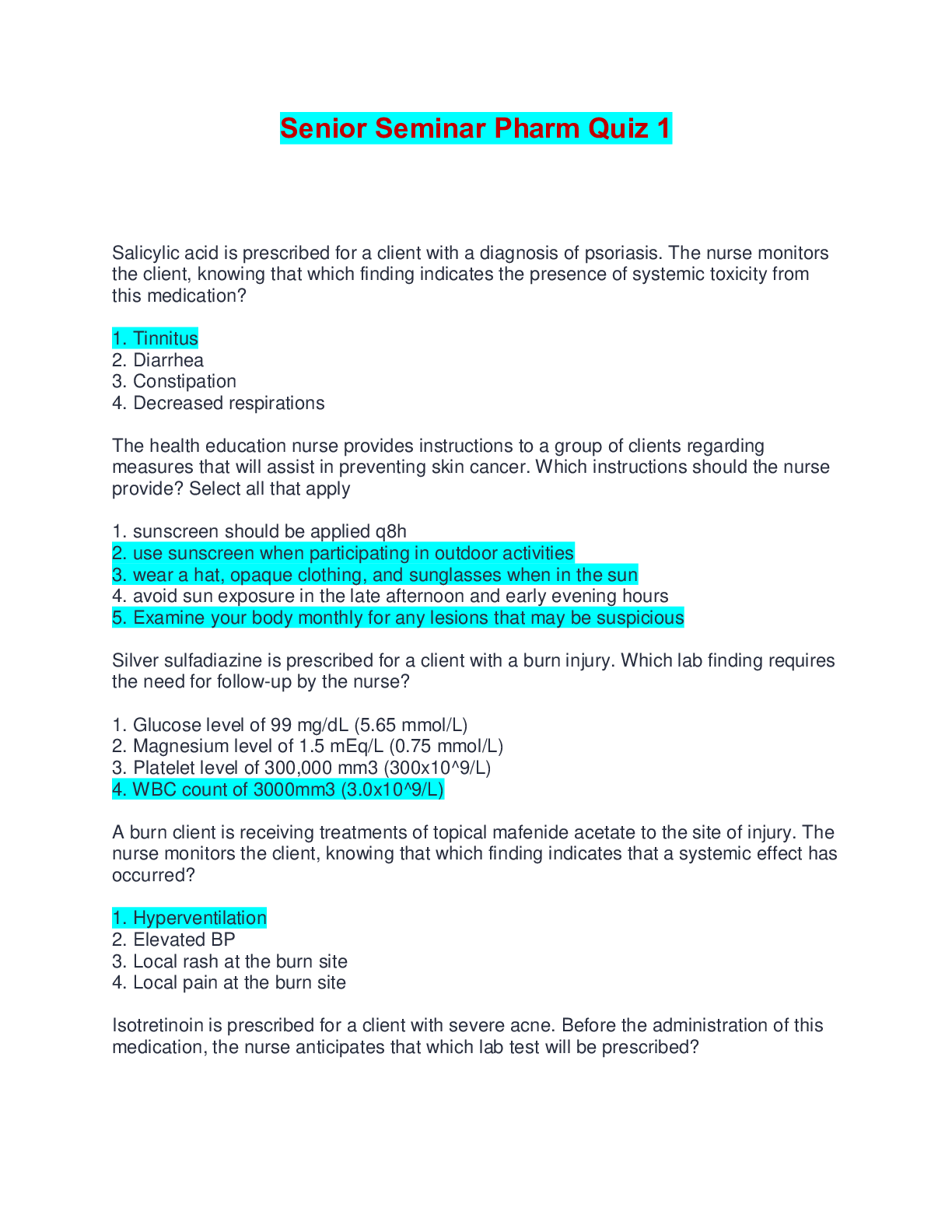
SENIOR SEMINAR QUIZ 1-6 BUNDLE
SENIOR SEMINAR QUIZ 1-6 BUNDLE
By Ajay25 7 months ago
$49.5
6
Reviews( 0 )
$18.00
Can't find what you want? Try our AI powered Search
Document information
Connected school, study & course
About the document
Uploaded On
Nov 20, 2024
Number of pages
23
Written in
Additional information
This document has been written for:
Uploaded
Nov 20, 2024
Downloads
0
Views
14

